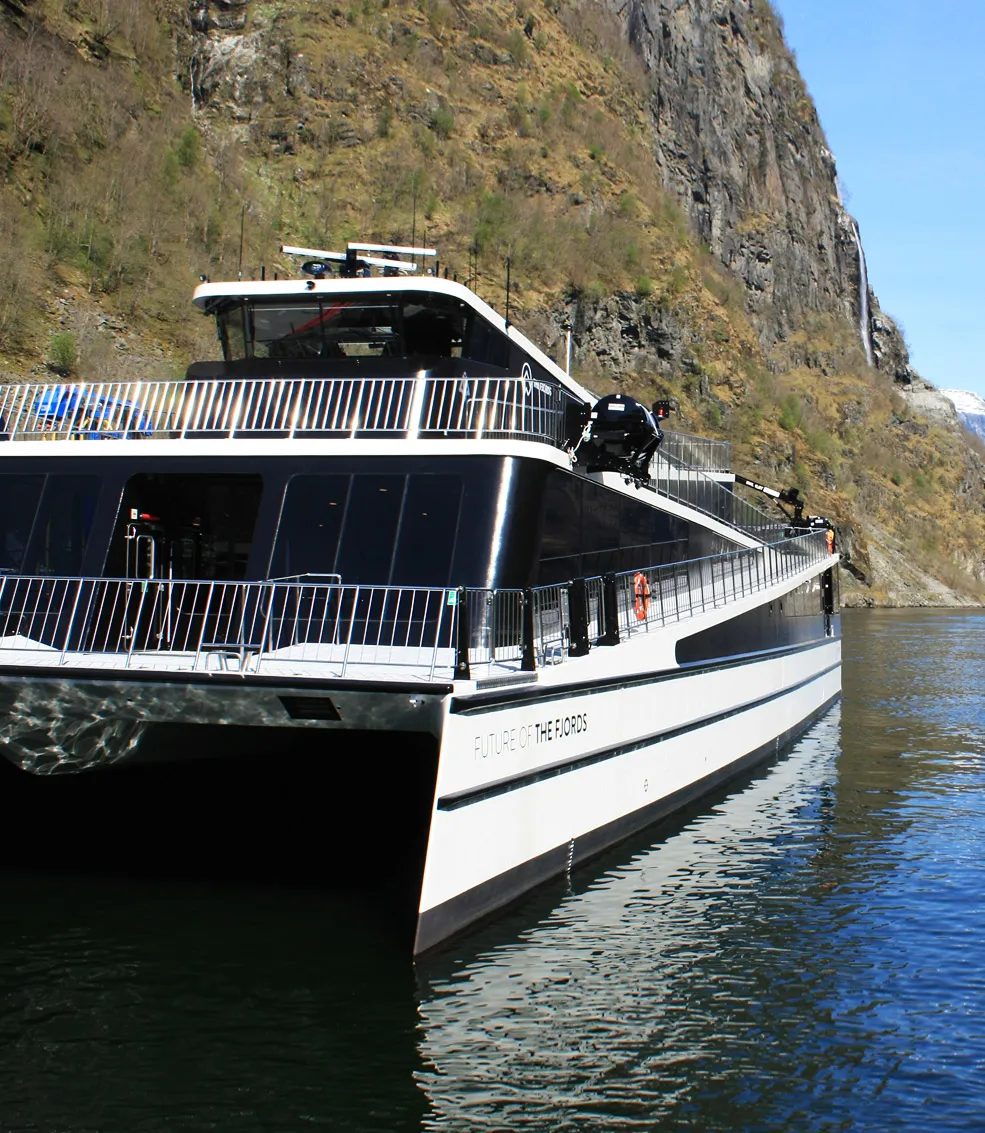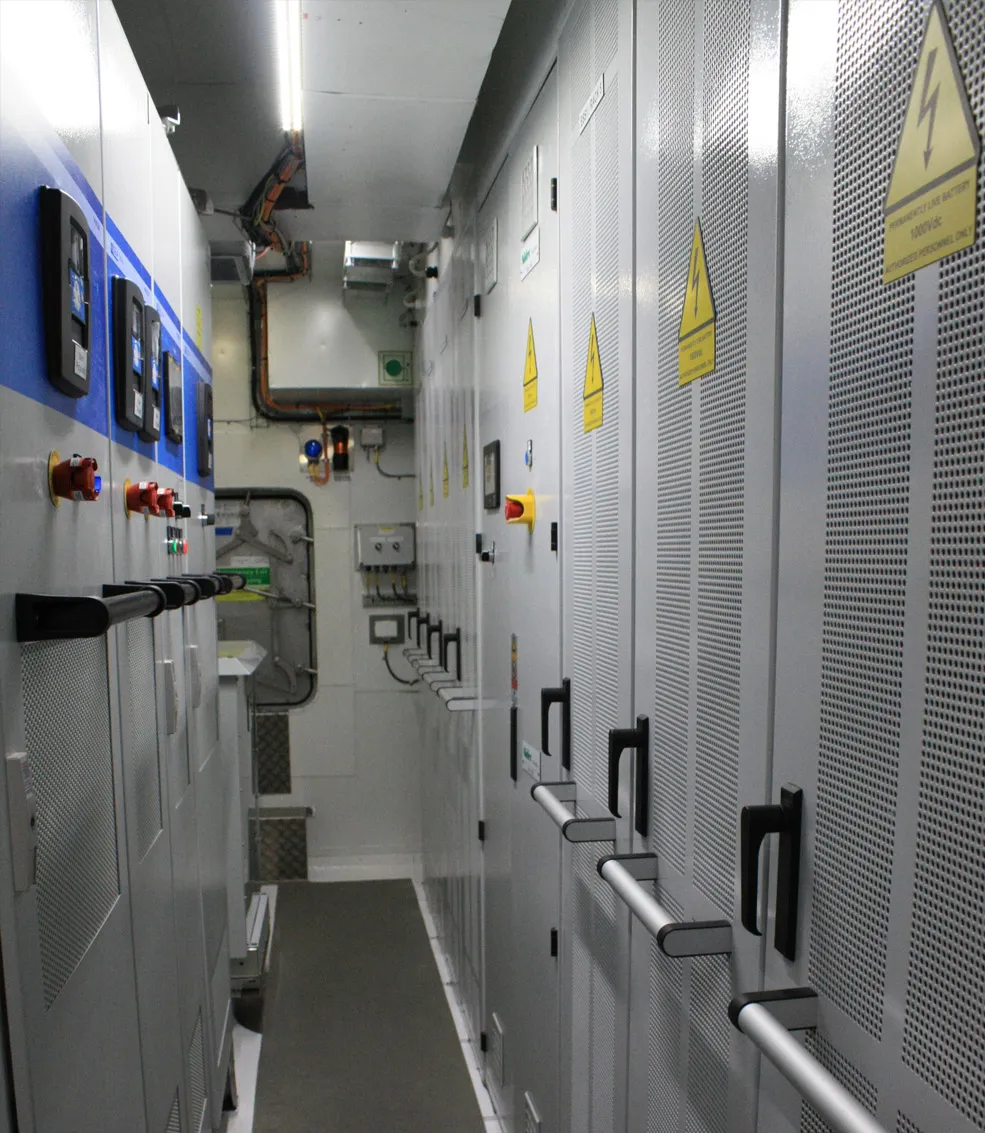Bringing the future to life
A bold new step towards a greener transport infrastructure, Future of The Fjords is the result of a brilliant new concept combined with proven expertise and a can-do mindset.
A voyage on board Future of The Fjords is like no other. As the ship’s catamaran hull slices through the crystal waters of Sognefjord, towering rock walls with 1,000 m peaks seemingly close in to embrace the vessel, nearly blocking out the sun. The only sound is the collective gasps of passengers marvelling at the pristine UNESCO World Heritage-listed landscape as this striking, 42 m long carbon fibre ship brings them closer to nature than ever before – with zero noise, zero emissions and the ultimate fjord experience.

Realizing ambitions
Launched in May this year, Future of The Fjords is a game changer for the passenger vessel segment. Sharing the zigzag design of her sister ship Vision of The Fjords, which mirrors the twisting mountain paths they sail alongside, Future replaces her sibling’s dual-fuel solution with all-electric propulsion to ensure efficient, silent and environmentally responsible operation on the itinerary between Flåm and Gudvangen. An innovative charging solution enables her to gently bleed power from the local grid network, while also, uniquely, taking on sewage to ensure zero emissions to water.
It is, says Rolf A. Sandvik, CEO of shipowner The Fjords, a complete package that both serves and preserves the fragile beauty around the small hamlet of Flåm in West Norway.
“It has long been my ambition, and the ambition of our company’s progressive owners, Flåm AS and Norway’s largest ferry operator Fjord1, to launch a new breed of vessel that creates a blueprint for truly sustainable, responsible and memorable passenger transport,” explains the former cruise ship captain from the deck of his sparkling new craft. “Vision of The Fjords marked the start of that journey, with its diesel-electric propulsion system and a hull designed to minimize wake-induced shoreline erosion. But Future of The Fjords symbolizes the fulfilment of a dream. She offers an experience that immerses our passengers into the sensations of the fjord without impacting upon the natural beauty that brings them here. In that respect this craft is almost a portal, or a platform, to access the landscape, rather than a traditional ’ship‘. She is, quite simply, the Future.”

A new paradigm
The DNV GL-classed light craft, designed and built by Norway’s Brødrene Aa, has the capacity to take 400 passengers on the 90-minute trip from Flåm to Gudvangen, passing through the spectacular World Heritage-listed Nærøyfjord. Future and Vision are the only ships serving the area that operate year-round, with nearly 700 round trips per annum, exposing tourists from all over the world to the serenity of autumn and winter as well as spring and summer’s dazzling array of colours. The design of these ships allows passengers of all mobility to literally climb over their hulls as if they were pathways, while those insides can get almost as close to nature thanks to comfortable panoramic lounges. An unforgettable experience, but that is only half the story, Sandvik is keen to stress.
“In terms of operation we want this to be a new paradigm for the industry,” he states. “A demonstration of what can be achieved with the determination, investment and ambition to operate responsibly and sustainably. Not to mention the expertise of DNV GL and the technical ability of the yard and suppliers: This project shows how owners can pool unique competencies to tailor solutions that deliver optimal results for all stakeholders.”

Certifying excellence
DNV GL has been working with The Fjords since 2015, initially collaborating on the Vision of The Fjords project before moving on to Future of The Fjords in 2017. Principal Engineer Sverre Eriksen was a central member of a DNV GL team that oversaw all aspects of vessel verification, certifying everything from the original design drawings through to construction and all elements of on-board machinery.
Eriksen, a battery expert and an architect of DNV GL’s class rules for battery-driven vessels, was charged with a key responsibility. “My focus was electrical,” he explains. “There are hundreds, if not thousands, of diesel-electric vessels in operation, but very few all-electric, so this is an emerging area that demands proven expertise. All project stakeholders have to know that the batteries are installed correctly, safely and will operate as expected. For example, battery capacity and monitoring are key. The vessel can’t afford to “black out” in the middle of the fjord, so we need to have a system in place to collect capacity and charging data to ensure the captain can see exactly how many nautical miles he can travel. If you think about your laptop, as it ages it may say the battery is 100 per cent charged but then only lasts an hour. We can’t have this situation with a vessel, so safeguards and systems have to be in place to ensure reliable, safe and efficient operation.”
He continues: “As a leader in the field of verifying this increasingly in-demand vessel type, we are here to offer expertise, hands-on assistance and operational peace of mind. It’s been a really exciting journey, with a client who is genuinely breaking the mould within their niche segment.”

Charging innovation
Future of The Fjords electric propulsion is delivered by two 450 kW motors enabling cruising speeds of 16 knots, which require a charging capacity of 2.4 MWh when the ship docks in Gudvangen. However, as Sandvik explains, initial conversations with local energy supplier Aurland Energiverk were far from promising in this regard.
“We had a meeting with Brødrene Aa and Aurland in which they explained they could only offer a charging capacity of 1.2 MWh through the grid, half what the vessel requires. So we needed a completely new, innovative approach to bring the electric concept to life.”
“It was then that the yard suggested that Westcon, the battery supplier, could provide a battery bank that could be sited shore-side and charge slowly throughout the day. This would allow it to top up energy capacity without any disruptive, and expensive, power surges. I then asked if it would be possible to somehow float the unit. My thinking here was both flexibility and cost, as it would negate the need for expensive land-based infrastructure while giving us the freedom to move the vessel, and the charging solution, when required,” says Sandvik.
At this point the next trailblazing idea emerged. The floating “Powerdock” concept, as it would be christened, was innovative enough, but what if it could solve another pressing environmental problem? “At present every other vessel operating on these stunning waterways simply dumps its sewage into the water,” Sandvik laments. “There are currently no regulations governing this for domestic trade. But we wanted to do things differently. That made me think: ‘could this charging solution also operate as a storage unit for black water?’ So I suggested it.”

Electrifying ideas
The designers at Brødrene Aa got to work. What they came up with was a 40 m long, 5 m wide floating dock containing battery packs capable of charging the vessel in just 20 minutes. Constructed from carbon fibre composite, and designed to complement the ship’s style, the dock also features storage room for on-board consumables, a diesel tank for Vision and a 20 m3 tank for receiving grey and black water, which is then taken to the on-shore sewage treatment plant. “Thus, the sewage problem is solved,”
Sandvik smiles with satisfaction, “giving us the greenest passenger vessel in Norway and helping us preserve the integrity of our beautiful fjords.” But it doesn’t stop there. Sandvik believes the Powerdock has the potential to unlock green transport on land as well as on the water in any remote area where there is a need for electric ferries but no grid infrastructure to support them.
“Why stop at using the Powerdock for vessels?” he muses. “Here we have a solution that any form of electric transport can simply plug into without exerting strain on the grid. For example, electric cars, motorbikes or buses could utilize it – it can literally become a local green transport hub, one that is cost-effective, efficient and easy to install. In this way, together with the new benchmark it sets for responsible maritime operations, we see the potential impact of Future of The Fjords extending far beyond this beautiful landscape around us.”
The Fjords are now planning for the next stage of their fleet renewal programme. DNV GL is on board to help Sandvik continue this breathtaking voyage
Contact us

